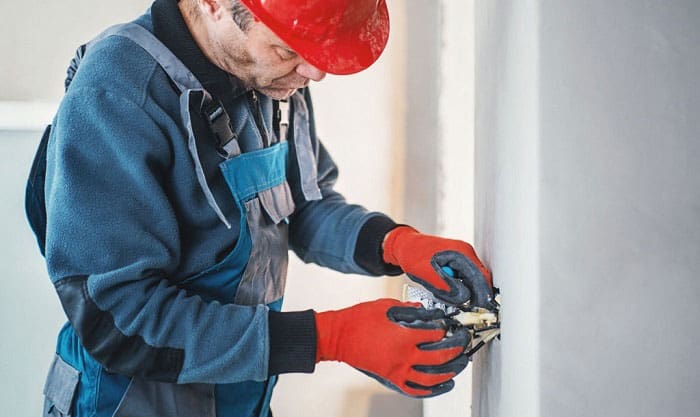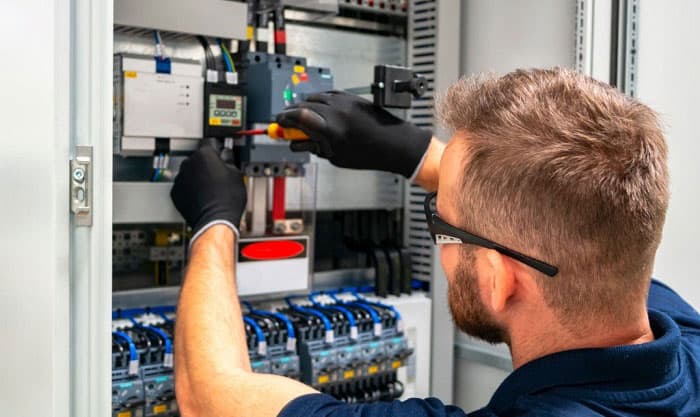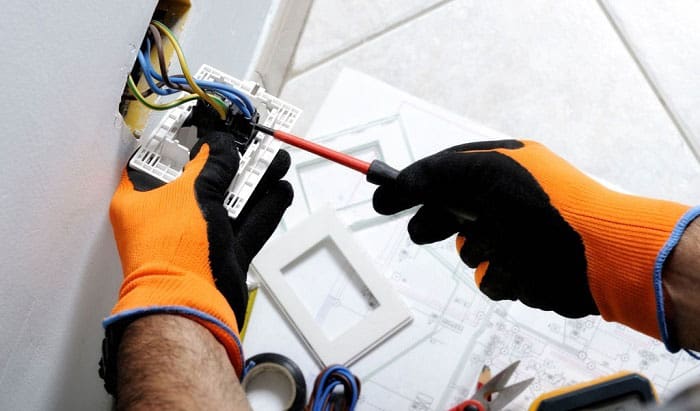Many times, the only barrier between you and a fatal live wire is the protective glove. Whether you are a professional electrician or a person trying to fix his/her household electrical wirings, learning safety information is crucial. We’re glad you research before wildly putting yourself at risk. Unfortunately, the response to “Do leather gloves protect from electric shock?” is no.
Regular leather gloves are not designed to withstand heat, arc flash, or electric shock. Though manufacturers sometimes add leather details to electrical safety gloves, the leather itself is not an insulating material. Plus, gloves for electrical workers must meet rigorous standards set by ASTM (American Society for Testing and Materials) and OSHA (Occupational Safety and Health Administration).
Table of Contents
Do Leather Gloves Prevent Electric Shock?
Though leather is an incredibly tough and long-lasting material, it is not the best option for electrical work. Generally, leather gloves protect against electricity when the voltage is lower than 450 volts.
In case you don’t know, U.S. household electricity is delivered in three wires, of which two are hot and one is neutral. The voltage between a neutral wire and a hot wire is from 110 to 120 volts. Meanwhile, between two neutral wires is 220 to 240 volts.
That isn’t to say such gloves can protect you from domestic current because the actual household voltage can vary, especially when there are electrical faults caused by an overload.
According to the OSHA 1910.269 standards, you have to equip yourself with voltage-rated safety gloves when working with over 50-volt currents. However, regular leather gloves are not voltage-rated ones. Check out this video to learn “why do leather gloves conduct electricity?”
Sometimes, manufacturers combine grain leather and silicon or other composite materials to produce electrical-insulating gloves. But leather itself is rarely used as a protective barrier for electricity.
Nonetheless, you might have come across leather protectors. Those are purpose-built leather gloves worn on top of rubber insulating gloves for more protection power. Such leather gloves prevent electric shock because:
- Unlike rubber, premium full-grain leather won’t ignite, drip, or melt when it is exposed to an arc flash.
- Leather is heat-stabilized. When electricians work with hot wires for an extended period, both the actual insulating gloves and the leather protectors won’t be damaged.
- Leather can resist cuts, abrasions, and punctures, which are also common hazards when dealing with electricity.
So, if leather gloves cannot prevent electric shock and voltage, then what kinds of gloves will protect you?
What Is an Electrical-insulating Glove?
An electrical-insulating glove can be made from natural or synthetic rubber, silicon grain leather, or composite materials. The materials must be dielectric, physically strong, durable, and flexible. To qualify products as insulated electrical gloves, manufacturers must prove they meet or exceed the current requirements of ASTM D120 specifications.
After that, the gloves are categorized into different voltage protection levels as listed in the table below. In addition, you can tell the gloves’ ozone resistance by checking their type on the last column to the right. Type I means the gloves cannot resist ozone, while type II means the gloves can.
Since live currents are highly dangerous, OSHA requires electrical safety gloves to be maintained properly and inspected for damages regularly. Also, if an incident happens, the gloves should be taken off and inspected instantly. The inspection procedure includes:
- An air test – This is carried out every day before workers use their gloves. A tester fills the glove with air and checks for leakages by listening for the sound of escaping air. This can be done manually or by an inflator. Then, the tester will turn the glove inside out and repeat the procedure.
- An electrical test – This is done periodically, wherein the gloves are put under given voltages. If the gloves haven’t been in use for twelve months, they must undergo electrical tests.
So, whatever you plan to use for your electrical work, always inspect them carefully. First, look for holes, discoloration, or tears. Then, proceed with the air test. For examining the gloves’ sleeves, roll and stretch them to spot defects more easily. Remember that learning how to use safety gloves is as important as purchasing suitable ones for your job.
To maximize protection, electricians should always follow a glove system each time they come in contact with high voltage current. A safety glove system consists of:
- Rubber insulating gloves that feature the right voltage protection level and type.
- Liner gloves to help absorb perspiration, provide warmth, and enhance comfort.
- Leather protectors that can resist arc flash, cuts, and punctures.
Electricity Safety Precautions
Besides wearing proper PPE, follow these electricity safety precautions when fixing wires at home:
- Avoid water and metal at all times as they increase electric conductivity. Never touch electrified equipment when your hands, shoes, and/or clothes are wet. Stay away from steel or aluminum ladders and surfaces.
- Always turn off the main circuit breaker and inform everybody in the house so that no one accidentally switches it on.
- Use an electricity tester pen to make sure the wire is de-energized before repairing. Check all the connected wires before proceeding. Under no circumstances should you touch a live wire, even when wearing rubber insulating gloves. Ask for professional help if you need to fix running currents.
- Examine all the GFICs (Ground Fault Circuit Interrupters) in your house to ensure they function properly every month. GFICs are designed to immediately shut down the power in the event of an overload or short circuit fault. Hence, they will prevent electric shock hazards.
Conclusion
To sum up, insulating gloves are among the most important PPE for electrical workers. Though leather gloves cannot protect you from electric hazards, the provided information should help you get appropriate safety gear when working with currents and wires.
If you find the article on do leather gloves protect from electric shock helpful, share it with people around you who need this. We welcome all thoughts and questions via the contact page. So, don’t hesitate to reach out. Thank you for reading!

Veronica is our content editor. She is a talent in delivery. Her main work is editing and writing articles that are both informative and simple to follow. She is in charge of synthesizing our understanding of what personal protection equipment (PPE) is needed in each job, how to best apply it, and how to visualize that equipment.




